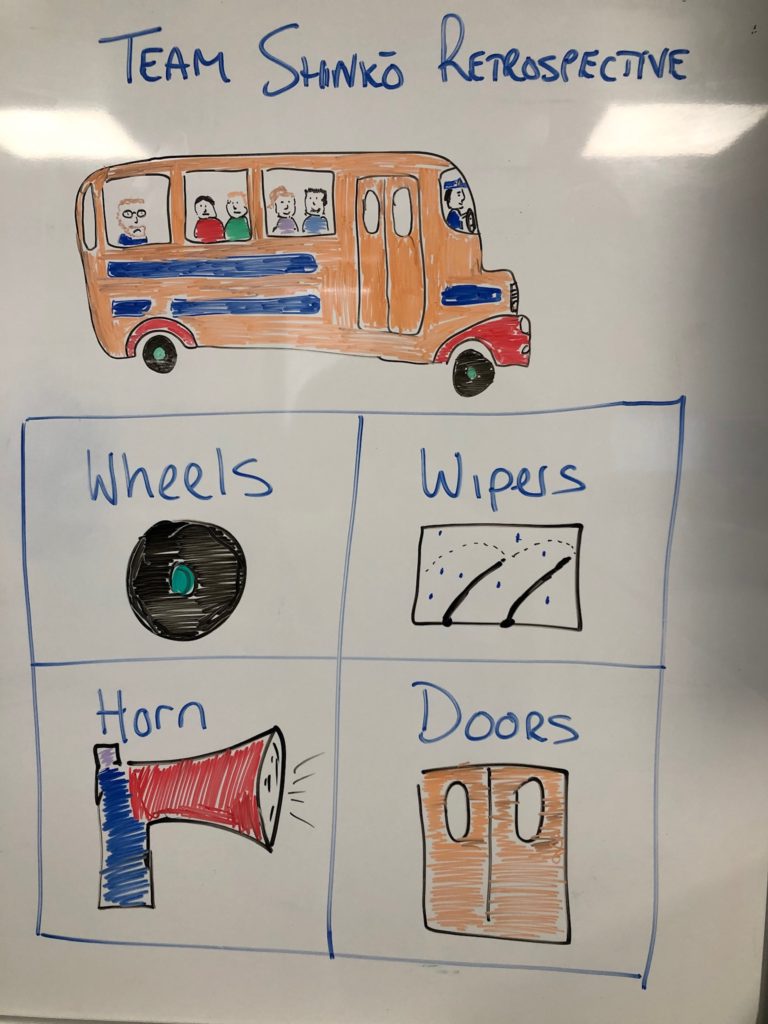Last week I walked into the office to be told that a members of my team – I shall call him Scott*, because that is his name – had not had a very enjoyable journey into work. Scott gets the bus into work and on this particular morning he had been joined by large number of school children who proceeded to sing the nursery rhyme ‘The Wheels on the Bus’. For Scott, this was not his first, and I’m sure that it won’t be his last, bus ordeal. It was a horrendous start to Scott’s day, but this was only the beginning.
As a supportive and caring team we decided that we needed to rally round Scott in order to brighten up his day and to try and make him happier, or at least less unhappy. In order to do this the team arrived at the daily stand-up early and as Scott walked into the team booth, we all started to sing “The wheels on the bus go round and round…”. Now I must say this did bring a smile to Scott’s face and showed the camaraderie that had been built within the team.
The team hold a retrospective every other week and I have previously been asked by Scott what I will be drawing on our whiteboard as the basis for discussions. I do not profess to be the greatest artist, but my sketches have included a scene from Back to the Future, a Christmas tree, New Year’s fireworks on the London Eye and a hot air balloon. For our retrospective this week, I wanted to ensure that we had another drawing that pleased both Scott and the team.
In order to try and assist in Scott’s recovery from what has been another traumatic commute, I did what any Scrum Master would do and combined my limited drawing ability and Scott’s recent public transport experience. To do this, I created a totally new retrospective, although it follows the premise of both the hot air ballon and speedboat retrospectives.
This retrospective is called, surprisingly, ‘The Wheel on the Bus Retrospective’.

There are multiple verses to the nursery rhyme ‘The Wheels on the Bus’, and this retrospective uses four of them. The focus of each verse sets the focus of a question that the team would look to answer.
The wheels on the bus go round and round – what can the team do to keep things moving forward?
The wipers on the bus go swish, swish swoosh – what can the team do to increase visibility/transparency?
The horn on the bus goes beep, beep, beep – what can the team do to remove/limit noise/distractions?
The doors on the bus open and close – what do the team need to better understand change(s)?
I asked the team to write their thoughts on post-it notes in order to answer these questions, before we reviewed each category, grouping similar themed responses. The team then identified actions that they wanted to take in order to ensure that the wheels keep turning, the wipers ensure visibility/transparency, the horn identifies distractions and we understand the doors of change.
The team, including Scott, thoroughly enjoyed this retrospective. The problem I find myself with now, is that I may have set the bar a little too high for myself for our next retrospective.
Below are the brief instructions for running this retrospective. It would be great to receive feedback from you and your team on the format of this retrospective and it’s ability to generate valuable actions.
Instructions for running the ‘Wheel on the Bus’ retrospective
Run time: 1 hour (dependent on discussions)
Equipment required: White board (or similar), post-it notes, pens
- Depending on your artistic ability, draw a bus and grid containing images representing wheels, wipers, a horn and doors (alternative print pictures and put these on a wall/whiteboard)
- Explain to you team the meaning of each segment and questions to be answered
- Distribute post-it nots and pens and ask the team to write down their thoughts, comments and/or questions (ideally at least one post-it note per person per segment)
- Review and discuss each segment in turn, grouping common responses
- Create actions and assign owners
* Please note that no Scott’s were harmed as a result of the above activities. Scott’s permission and endorsement was received before publishing this blog post.
